Discover 35 hidden attractions, cool sights, and unusual things to do in Genoa (Italy). Don't miss out on these must-see attractions: Acquario di Genova, Palazzi dei Rolli, and Galata Museo del Mare. Also, be sure to include Palazzo San Giorgio in your itinerary.
Below, you can find the list of the most amazing places you should visit in Genoa (Liguria).
Table of Contents
Acquario di Genova
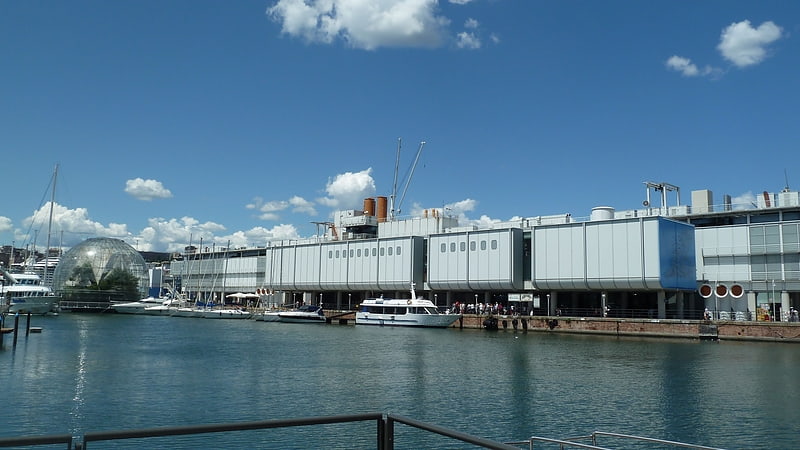
Vast aquarium in ship-like building. The Aquarium of Genoa is the largest aquarium in Italy. Located in the old harbour area of Genoa, Italy, the 33,000-square-foot aquarium is a member organization of the European Association of Zoos and Aquaria, and welcomes more than 1.2 million visitors each year.[1]
Address: Ponte Spinola, 16128 Genova
Palazzi dei Rolli
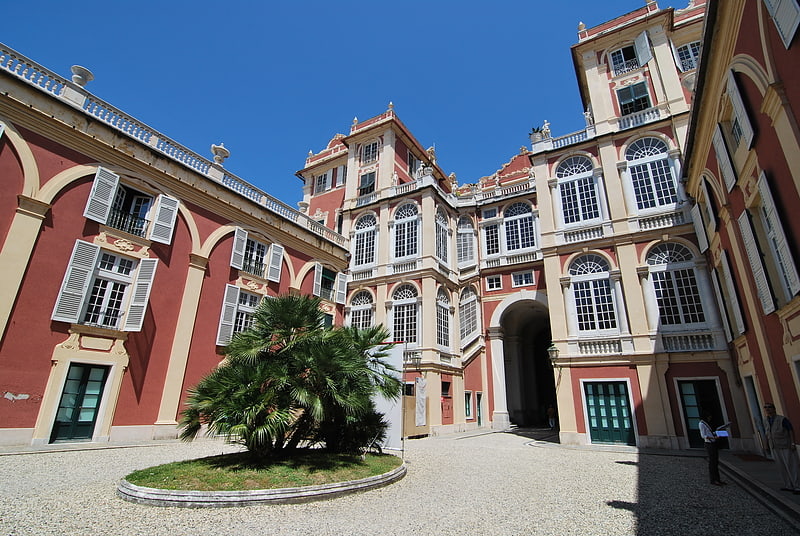
Historical place in Genoa, Italy. Genoa: Le Strade Nuove and the system of the Palazzi dei Rolli is a UNESCO World Heritage Site which includes a number of streets and palaces in the center of Genoa, in Northwestern Italy.
- The Strade Nuove are a group of streets built by the Genoese aristocracy during the expansion of the city at a time when the Republic of Genoa was at the height of its financial and seafaring power. These are Via Giuseppe Garibaldi and Via Balbi, later followed by Via Cairoli.
- The Palazzi dei Rolli are a group of palaces - most of which also date from the late 16th and early 17th centuries - which were associated to a particular system of ‘public lodging’ in private residences, whereby notable guests on State visit to the Republic were hosted in one of these palaces on behalf of the State.
On 13 July 13, 2006, forty-two of the 163 palaces originally included in one the five public list called "Rolli" were selected as a World Heritage Site by the UNESCO special committee meeting in Vilnius. The site includes an ensemble of Renaissance and Baroque palaces along the so-called ‘new streets’, which offer an extraordinary variety of different solutions, achieving universal value in adapting to the particular characteristics of the site and to the requirements of a specific social and economic organization. They also offer an original example of a public network of private residences designated to host state visits.
On January 20, 2007, UNESCO unveiled a plaque in via Garibaldi, the former Strada Nuova, explaining the reasons for inclusion of the Strade Nuove and the system of the Palazzi dei Rolli within the World Heritage Sites:
The largest homes, various in shape and distribution, that were chosen at random in the lists to host visits of state. The buildings, often built on sloping land, formed of a stepped atrium - courtyard - staircase - garden and rich interior decorations, express a singular social and economic identity and commencement of modern age urban architecture in Europe.
Some of the Palazzi dei Rolli are used today as public buildings, museums, offices and private residences. Among the palaces open to the public, Palazzo Rosso, Palazzo Bianco and Palazzo Doria Tursi jointly constitute the Strada Nuova Museums located in via Garibaldi.[2]
Address: Via Garibaldi, 16124 Genoa (Centro Est)
Galata Museo del Mare
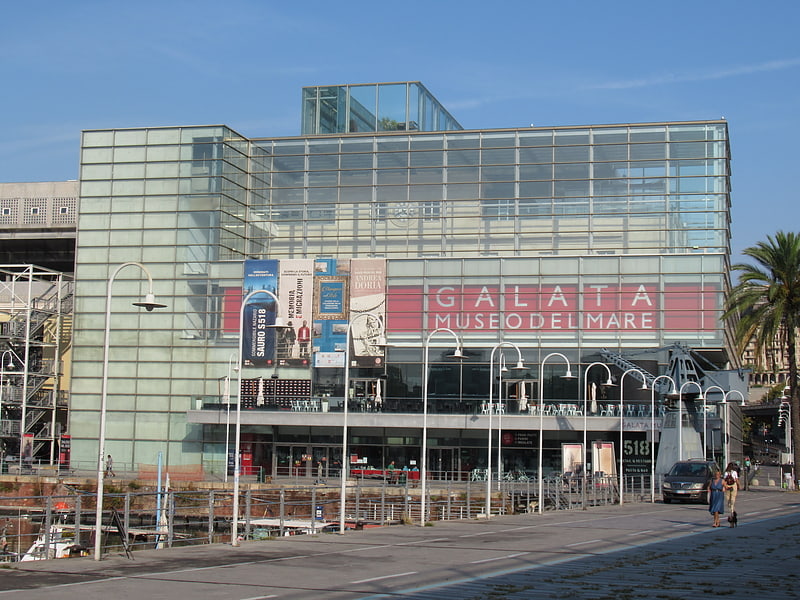
Museum in Genoa, Italy. The Galata - Museo del mare is a maritime museum in the Italian city of Genoa. It is the largest museum of its kind in the Mediterranean area and also one of the most modern in Italy. The museum is located on the grounds of the Porto Antico, in the Palazzo Galata in the Darsena district, where galleys were built in the Republic of Genoa era. It is close to downtown Genoa, the Port of Genoa, and within walking distance of Genova Principe train station and Darsena metro stop. It opened in 2004 as part of Genoa's 2004 European Capital of Culture celebration.[3]
Address: Calata Ansaldo De Mari, 1, 16126 Genova
Palazzo San Giorgio
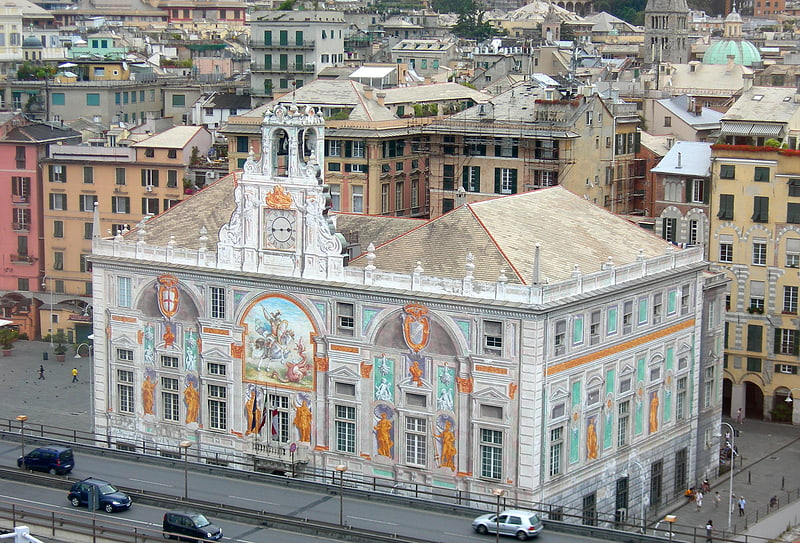
Palace in Genoa, Italy. The Palazzo San Giorgio or Palace of St. George is a palace in Genoa, Italy. It is situated in the Piazza Caricamento.
The palace was built in 1260 by Guglielmo Boccanegra, uncle of Simone Boccanegra, the first Doge of Genoa. For the construction of the new palace, materials were used from the demolition of the Venetian embassy in Constantinople, having been obtained from Byzantine Emperor Michael VIII as a reward for Genoese aid against the Latin Empire. Stone lions – the emblem of Venice's patron St Mark – were displayed as trophies on the facade by her bitter rival, the Republic of Genoa. The palace was intended — through the creation of a civil-political center — to separate and elevate the temporal power of the Republic's government from the religious power of the clergy, centered on the Cathedral of San Lorenzo.
In 1262, Guglielmo Boccanegra was deposed and forced into exile. The palace was used for a time as a prison; Marco Polo was its most famous resident and it was there that he dictated his memoirs to Rustichello of Pisa.
In the 15th century, the palace became home to the Bank of Saint George.[4]
Address: Palazzo San Giorgio, 2, 16126 Genova (Centro Est)
Palazzo Doria

Palace. The Palazzo Doria or Palazzo Andrea e Gio. Batta Spinola is a palace located in Via Garibaldi, in the historical center of Genoa, in Northwestern Italy. It was one of the 163 Palazzi dei Rolli of Genoa, the selected private residences where the notable guests of the Republic of Genoa were hosted during State visits. On 13 luglio del 2006 it was included in the list of 42 palaces which now form the UNESCO World Heritage Site Genoa: Le Strade Nuove and the system of the Palazzi dei Rolli.
The palace is the property of the Doria family and has a residential use. Only the exterior and limited internal areas are open to the public.[5]
Villa Durazzo-Pallavicini
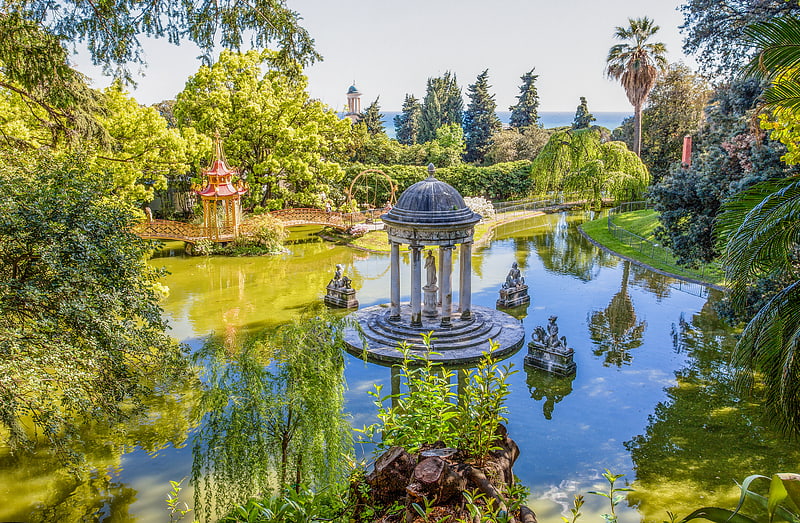
Estate with a villa and botanical garden. The Villa Durazzo-Pallavicini is a villa with notable 19th-century park in the English romantic style and a small botanical garden. The villa now houses the Museo di Archeologia Ligure, and is located at Via Pallavicini 13, immediately next to the railway station in Pegli, a suburb of Genoa, Italy. The park and botanical garden are open daily.
The estate was begun in the late 17th century by Clelia Durazzo Grimaldi, who established the Giardino botanico Clelia Durazzo Grimaldi at that time. Today's park was created by her nephew Ignazio Alessandro Pallavicini after he inherited the property.
The park was designed by Michele Canzio, set designer for the Teatro Carlo Felice, and built between 1840 and 1846. It covers some 97,000 m2 of hillside behind the villa. Although recognizably in the English romantic style, the garden is highly theatrical, to the point of being organized as a series of scenes forming a play with prologue and three acts (Return to Nature, Memory, Purification). Structures and statues through the garden form focal points to this libretto.
When the park opened in September 1846, on the occasion of the VIII Congresso degli Scienziati Italiani, it quickly gained national fame. In 1928 its current owner, Matilde Gustinani, donated both park and botanical garden to Genoa for use as a public park. Through the remainder of the 20th century, the garden fell into some disrepair, and indeed was threatened in 1972 by construction of a nearby highway. Its restoration began in 1991, however, in honor of Columbus' discovery of America. As of 2006 about half of the park is open for visitors.
In 2017 the park was elected the most beautiful garden in Italy.
The park contains two ponds, a dozen notable structures, various statues, and an extensive grotto. The grotto represents a Dantesque inferno, with walkways and subterranean lake through which the visitor may ascend to paradise. In former years, visitors could explore the grotto by boat. Structures include a Coffee House in the shape of triumphal arch, Rustic House, Madonna's Chapel, Mausoleum of the Captain, Temple of Diana, Flower House, Turkish Temple, Obelisk, and Chinese Pagoda.
The park also contains a number of plantings of botanical interest, including mature specimens of Araucaria bidwilli, Cedrus libani, Cinnamomum camphora, Jubaea chilensis, Notelaea excelsa, Firmiana simplex, Quercus suber, Podocarpus macrophyllus, many exotic palms and a stand of some 160 Camellia japonica.[6]
Piazza De Ferrari
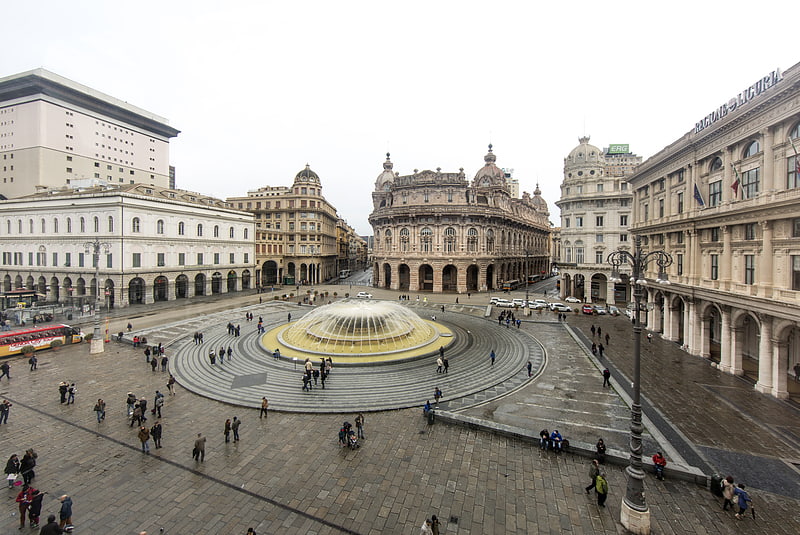
Grand square used for civic events. Piazza De Ferrari is the main square of Genoa. Situated in the heart of the city between the historical and the modern center, Piazza De Ferrari is renowned for its fountain, which was restored in recent years along with a major restyling of the square.
Today next to Piazza De Ferrari are numerous office buildings, headquarters of banks, insurances and other private companies, making of this district the financial and business centre of Genoa, so that the Genoese popularly refer to it as the "City" of Genoa. At the end of the 19th century Genoa was the main financial centre of Italy along with Milan, and Piazza De Ferrari was the place where many institutions were established, like the stock exchange, the Credito Italiano, the branch offices of the Bank of Italy, founded in 1893.[7]
Museo di Palazzo Reale
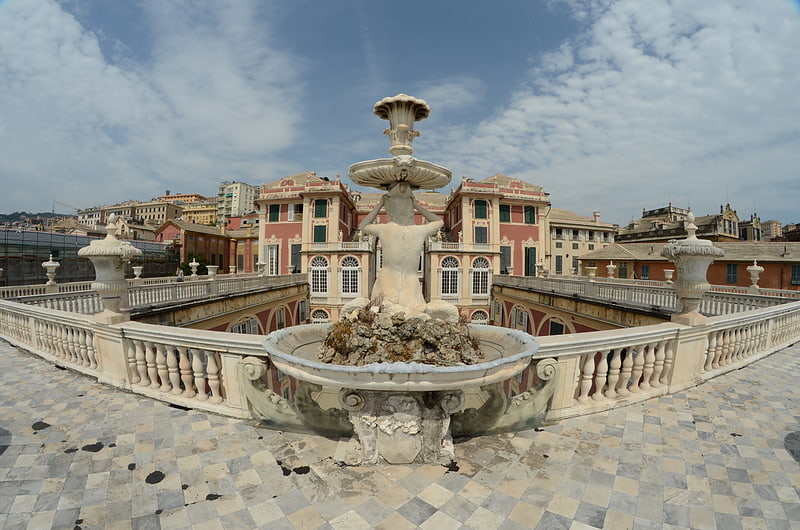
Also known as: Palazzo Reale
17th-century palace with art and frescos. The Palazzo Reale or Palazzo Stefano Balbi is a major palace in Genoa.[8]
Address: Via Balbi, 10, 16126 Genova
Edoardo Chiossone Museum of Oriental Art
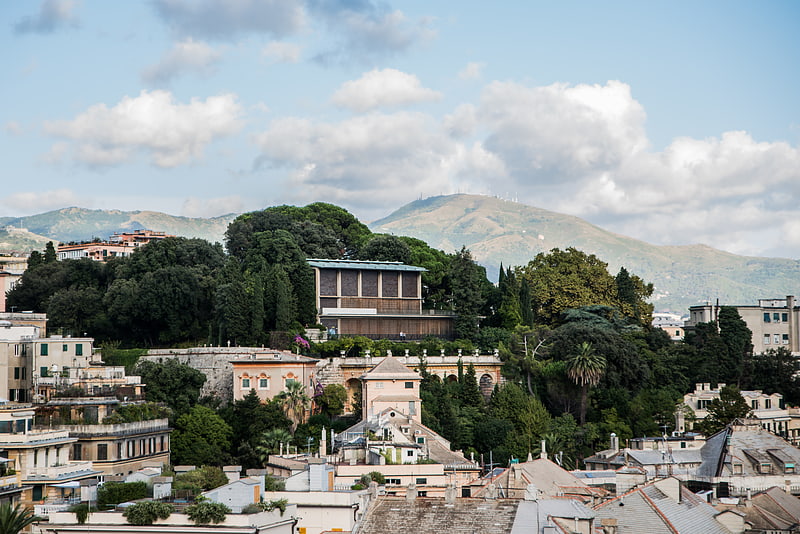
Also known as: Museo d'arte orientale Edoardo Chiossone
Japanese art and historical artifacts. The Edoardo Chiossone Museum of Oriental Art in Genoa is an important collection of Asian art, one of the most significative collections in Europe and in Italy, along with the museums of Venice and Rome.
The museum hosts the huge collection (over 15,000 pieces) of Edoardo Chiossone, who spent 23 years (1875-1898) in Japan.
The exhibition shows many objects and artworks from Japan and China, like sculptures, porcelain pieces, bronze vessels, prints, masks, Samurai armors and helmets.
It is situated inside Villetta Di Negro, a public park in the centre of Genoa, next to Piazza Corvetto and overlooking the historical centre and Via Garibaldi.
- Interiors of the museum photographed by Paolo Monti (1967)
Address: Piazzale Giuseppe Mazzini, 4, 16122 Genova (Centro Est)
Genoa Cathedral

Also known as: Cattedrale di San Lorenzo
1100s cathedral with a frescoed interior. Genoa Cathedral or Metropolitan Cathedral of Saint Lawrence is a Roman Catholic cathedral in the Italian city of Genoa. It is dedicated to Saint Lawrence, and is the seat of the Archbishop of Genoa. The cathedral was consecrated by Pope Gelasius II in 1118 and was built between the twelfth century and the fourteenth century as fundamentally a medieval building, with some later additions. Secondary naves and side covers are of Romanesque style and the main facade is Gothic from the early thirteenth century, while capitals and columns with interior corridors date from the early fourteenth century. The bell tower and dome were built in the sixteenth century.[10]
Address: Piazza San Lorenzo, 16123 Genova (Centro Est)
Palazzo Ducale

Museum in Genoa, Italy. The Doge's Palace is a historical building in Genoa, northern Italy.
Once the home of the Doges of Genoa, it is now a museum and a centre for cultural events and arts exhibitions. It is situated in the heart of the city, with two different entrances and façades, the main one on Piazza Umberto I, and the second one on Piazza De Ferrari.[11]
Address: Piazza Giacomo Matteotti, 5, 16123 Genova (Centro Est)
Cimitero Monumentale di Staglieno
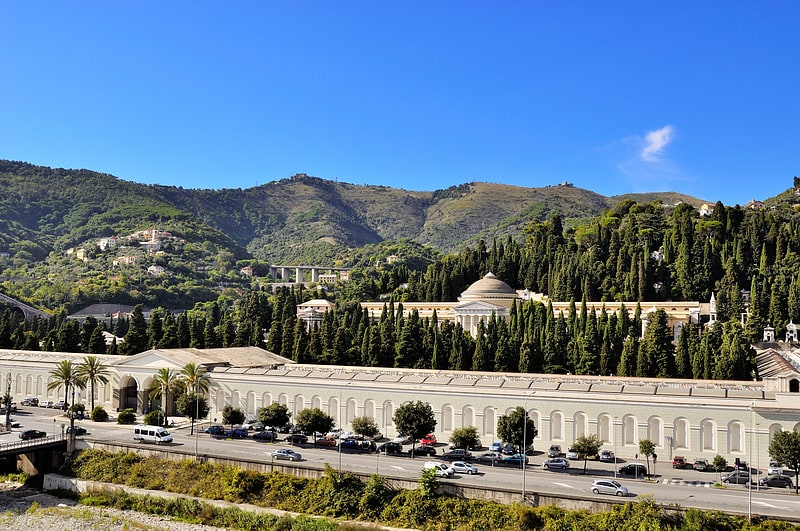
Also known as: Cimitero monumentale di Staglieno
Graveyard with ornately sculpted tombs. The Cimitero monumentale di Staglieno is an extensive monumental cemetery located on a hillside in the district of Staglieno of Genoa, Italy, famous for its monumental sculpture. Covering an area of more than a square kilometre, it is one of the largest cemeteries in Europe.[12]
Address: Piazzale Resasco, Genoa (Media Val Bisagno)
Lanterna di Genova

76m-tall stone lighthouse and city icon. The Lighthouse of Genoa, is the main lighthouse for the city's port. Besides being an important aid to night navigation in the vicinity, the tower serves as a symbol and a landmark for the City of Genoa. Built of masonry, at 76 m it is the world's fifth tallest lighthouse and the second tallest "traditional" one. Between 1543 and the construction of the lighthouse on Île Vierge, France in 1902, it was the tallest lighthouse in the world. When measured as a whole with the natural rock on which it stands, as it is commonly perceived and represented, its height is 117 m, which would make it the second tallest lighthouse in the world, the tallest in Europe, and the tallest traditional lighthouse.
It is constructed in two square portions, each one capped by a terrace; the whole structure is crowned by a lantern from which the light is shone. Rebuilt in its current shape in 1543 replacing the former lighthouse, it is the world's third oldest lighthouse, following the Tower of Hercules in A Coruña, Spain, and Kõpu Lighthouse, on the island of Hiiumaa, Estonia.[13]
Address: Via al Largo della Lanterna, 16126 Genova (Centro Ovest)
Neptune
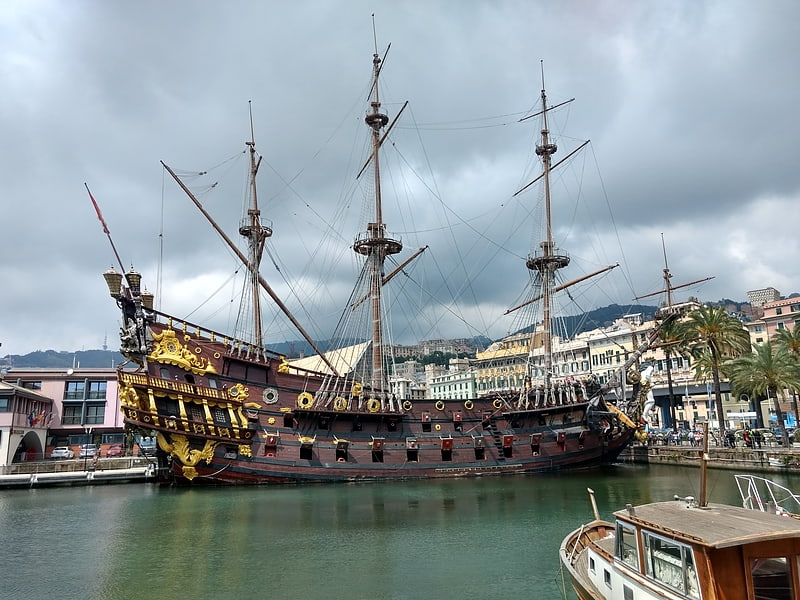
Ship. The Neptune is a ship replica of a 17th-century Spanish galleon designed by Naval Architect David Cannell of www.dmcmarine.com. The ship was built in 1985 for Roman Polanski's film Pirates, where she portrayed the Spanish ship of the same name. An accurate replica above the waterline, but sporting a partly steel hull, planked in timber and two main engines with Schottel drive, the Neptune is currently a tourist attraction in the port of Genoa, where its interior can be visited for a 9 euro entry fee. In 2011, she portrayed the Jolly Roger, the ship of Captain Hook, in the TV miniseries Neverland.[14]
Address: Area Porto Antico - Ponte Spinola, Genoa
Museo Villa Croce

Museum in Genoa, Italy. The Villa Croce Museum of Contemporary Art is a permanent collection of Italian and international contemporary art hosted in a villa in the Carignano quarter of Genoa, northwestern Italy. The villa, donated to the city by the Croce family in 1951, is surrounded by public park with sea views, overhanging the Fiera di Genova exhibition center. It contains more than 3000 works of arts.[15]
Stadio Luigi Ferraris
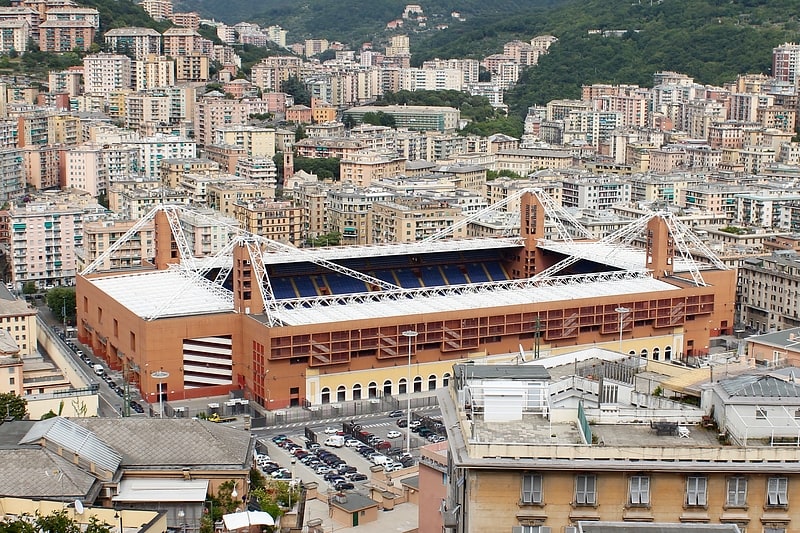
Stadium in Genoa, Italy. The Stadio comunale Luigi Ferraris, also known as the Marassi from the name of the neighbourhood where it is located, is a multi-use stadium in Genoa, Italy. The home of Genoa C.F.C. and U.C. Sampdoria football clubs, it opened in 1911 and is one of the oldest stadiums still in use for football and other sports in Italy. Aside from football, the stadium has hosted meetings of rugby in the Italian national team and, more rarely, some concerts.
The stadium is named after Luigi Ferraris, an Italian footballer, engineer and soldier who died during WWI.[16]
Address: Corso De Stefanis, 16139 Genova (Centro Est)
Palazzo Angelo Giovanni Spinola

The Palazzo Angelo Giovanni Spinola is a palace located in Via Garibaldi, in the historical center of Genoa, in Northwestern Italy. It was one of the 163 Palazzi dei Rolli of Genoa, the selected private residences where the notable guests of the Republic of Genoa were hosted during State visits. On 13 luglio del 2006 it was included in the list of 42 palaces which now form the UNESCO World Heritage Site Genoa: Le Strade Nuove and the system of the Palazzi dei Rolli. Now owned by a bank, it is possible to visit the areas open to the public.[17]
Casa di Cristoforo Colombo
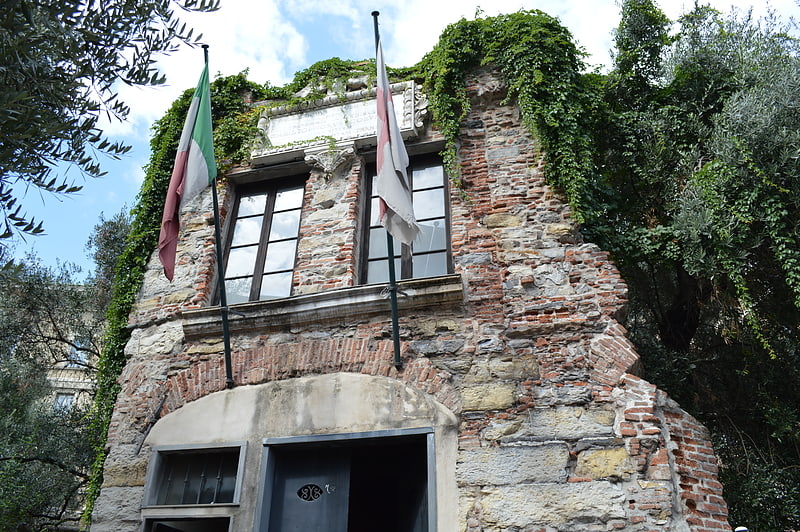
Historical place in Genoa, Italy. The Christopher Columbus House in Genoa, Italy, is an 18th-century reconstruction of the house in which Christopher Columbus grew up.[18]
Address: Piazza Dante, 16122 Genova (Centro Est)
Palazzo Clemente Della Rovere

The Palazzo Clemente Della Rovere is a palace located in Piazza Rovere in the historical center of Genoa, Northwestern Italy. The palace was one of the 163 Palazzi dei Rolli of Genoa, the selected private residences where the notable guests of the Republic of Genoa were hosted during State visits. On 13 luglio 2006 it was added to the list of 42 palaces which now form the UNESCO World Heritage Site Genoa: Le Strade Nuove and the system of the Palazzi dei Rolli. The palace hosts today the General Consulate of Iceland.[19]
Biosfera
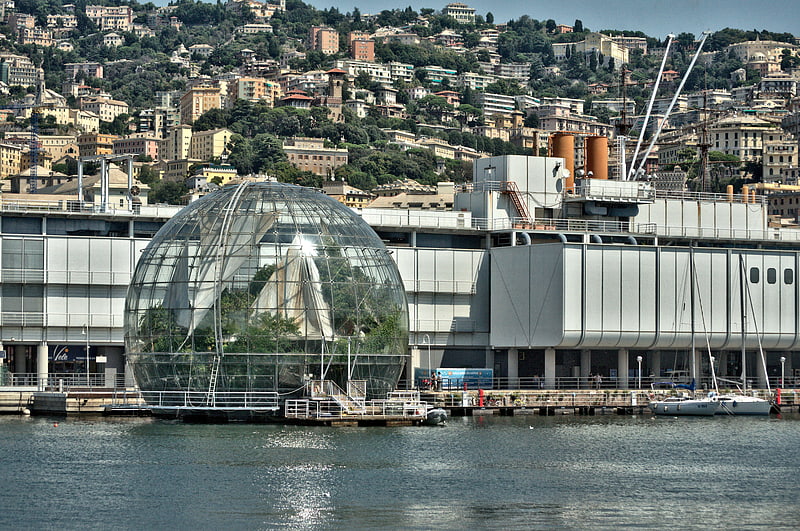
The Biosphere, commonly known as Renzo Piano's Bubble, is a glass and steel structure located in Genoa's Old Port and built in 2001. The structure, spherical in shape, with a diameter of 20 m, a total weight of 60 t and an exhibition area of about 200 m², is suspended over the sea at Ponte Spinola, in the immediate vicinity of the aquarium.
Teatro Carlo Felice
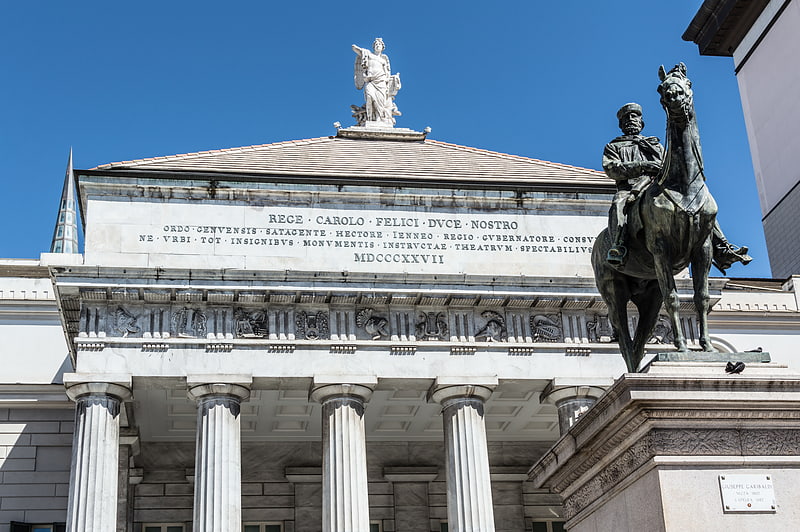
Opera house in Genoa, Italy. The Teatro Carlo Felice is the principal opera house of Genoa, Italy, used for performances of opera, ballet, orchestral music, and recitals. It is located on the side of Piazza De Ferrari.
The hall is named for King Carlo Felice, and dates from 24 December 1824, when the Most Excellent Department of Theatres was established. On 31 January 1825, local architect Carlo Barabino submitted his design for the opera house which was to be built on the site of the church of San Domenico. The Dominican friars were moved elsewhere without delay or ceremony, and the first stone of the new building was laid on 19 March 1826.
The inaugural performance of Bellini's Bianca e Fernando took place on 7 April 1828, even though the structure and decoration were not quite finished. The auditorium accommodated an audience of about 2,500 in five tiers (each with 33 boxes), a gallery above, and standing room in the orchestra pit. The acoustics were considered among the best of the time.
For nearly forty years from 1853, Verdi spent the winter in Genoa, but he had few strong professional ties with the Teatro Carlo Felice. In 1892, Genoa commemorated the 400th anniversary of Columbus' discovery of America and to celebrate the occasion the Carlo Felice was renovated and redecorated at a cost of 420,000 lire (nearly £17,000). Verdi was approached to compose a suitable opera, but he declined the honour, making the excuse that he was too old. Alberto Franchetti's opera Cristoforo Colombo premiered at the Carlo Felice on 6 October 1892.
The hall was altered many times in the years 1859–1934, and remained remarkably unscathed by war until 9 February 1941 when a shell fired by a British warship hit the roof, leaving a large hole open to the sky and destroying the ceiling of the auditorium which had been a unique example of 19th-century rococo extravagance, its main feature being a wide circle of angels, cherubs and other winged creatures in brightly painted high relief.
Further damage was sustained on 5 August 1943 when incendiary bombs started a backstage fire which destroyed all scenery and wooden fittings, but did not reach the main auditorium. Unfortunately additional damage was caused by looters who stripped the back of the theatre of every possible scrap of metal they could find. Finally, an air raid in September 1944 caused the destruction of the front of the theatre leaving virtually only the outside walls and the corridors behind the tiers of boxes standing. What had been the most richly beautiful of opera houses had become a skeleton of bare walls and roofless porticos.
After the war opera seasons were held for over forty years in an emergency venue, at the Cinema Teatro Margherita, later transformed into a department store
Reconstruction plans began immediately after the war's close. The first design by Paolo Antonio Chessa (1951) was rejected; the second by Carlo Scarpa was approved in 1977 but brought to a halt by his untimely death. Aldo Rossi ultimately provided today's design, in which portions of the original facade have been recreated but the interior is entirely modern. The hall officially reopened in June 1991, with a main hall holding up to 2,000 seats and a smaller auditorium holding up to 200 seats.
The theatre is the main location of the concert seasons of Giovine Orchestra Genovese, a concert society founded in Genoa in 1912.[20]
Forte Sperone
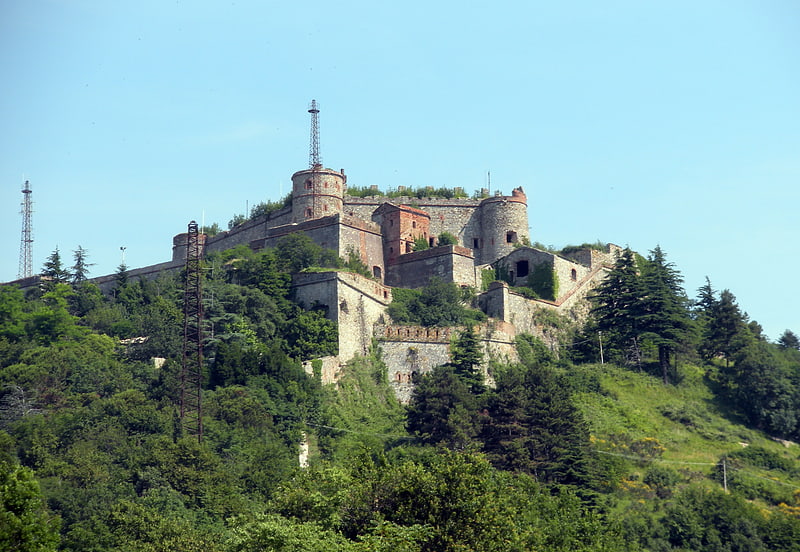
Fortress in Italy. Forte Sperone is a fortification included in the "New Walls" built to defend the Italian city of Genoa, located on top of Mount Peralto. The union of two walls, one on the side of Val Polcevera and the other on the side of Val Bisagno, gives the fort the appearance of the bow of a ship, from which its name derives. Due to its dominant position, it was one of the most important structures of the fortifications of Genoa.[21]
Palazzo Rosso
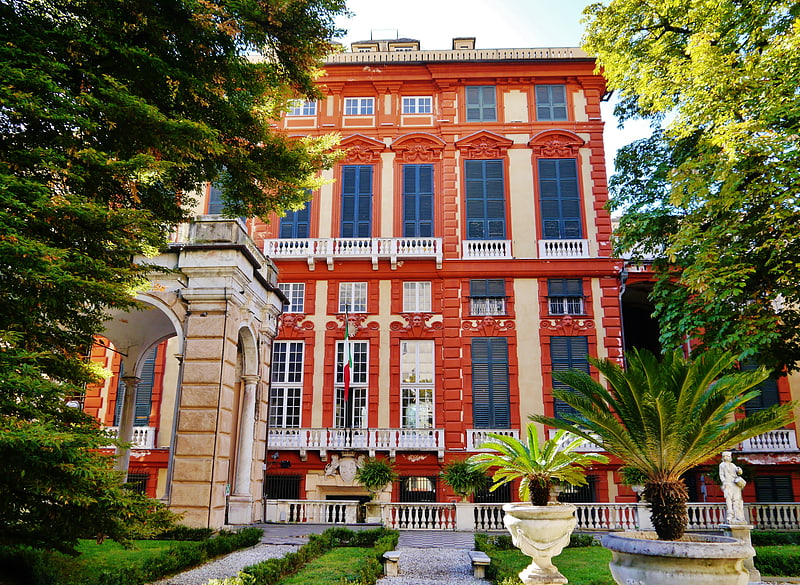
Art museum in grand palazzo with frescos. The Palazzo Brignole Sale or Palazzo Rosso is a house museum located in Via Garibaldi, in the historical center of Genoa, in Northwestern Italy. The palace is part of the UNESCO World Heritage Site Genoa: Le Strade Nuove and the system of the Palazzi dei Rolli. The rich art collection inside, along with the galleries of Palazzo Bianco and Palazzo Doria Tursi, is part of the Musei di Strada Nuova and consists of the works of artists of the caliber of Antoon van Dyck, Guido Reni, Paolo Veronese, Guercino, Gregorio De Ferrari, Albrecht Dürer, Bernardo Strozzi and Mattia Preti.[22]
Villa Grimaldi Fassio
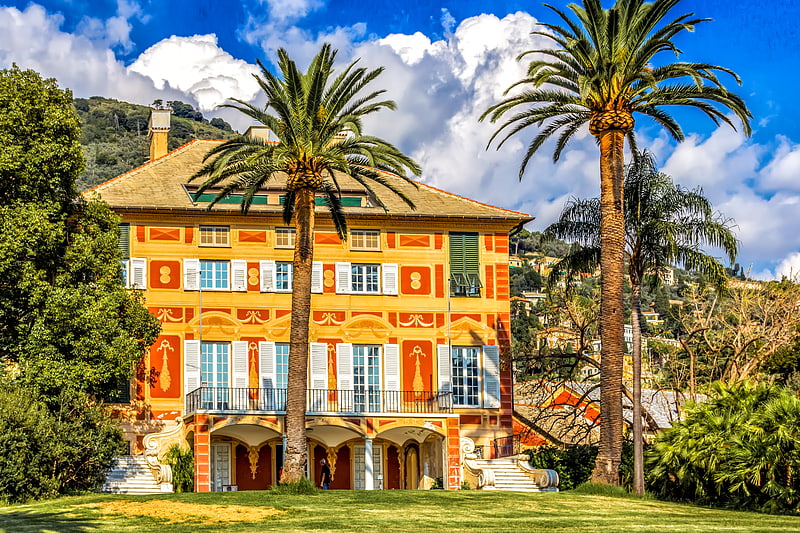
The Villa Grimaldi Fassio is a civil building located in the Nervi district, in via Capolungo, in the municipality of Genoa. Municipal property, and located in the parks of Nervi, it has been the seat of the Raccolte Frugone since 1993.[23]
Arco della Vittoria
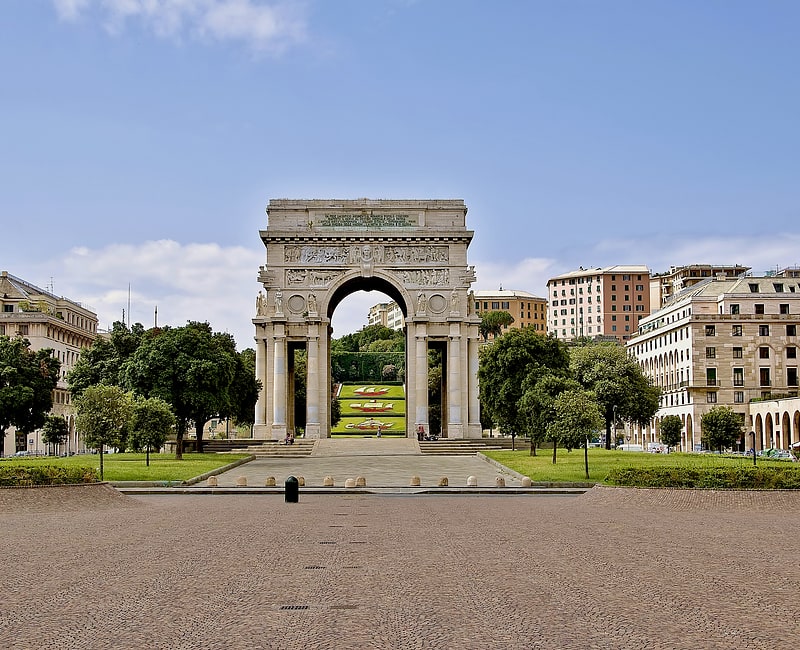
The Arco della Vittoria, also known as Monumento ai Caduti or Arco dei Caduti, is a memorial arch located in Piazza della Vittoria in Genoa, Italy. It is dedicated to the Genoese who died during World War I, and it was inaugurated on 31 May 1931.[24]
Diocesan Museum

Also known as: Museo diocesano
Museum in Genoa, Italy. The Diocesan museum of Genoa is located in Genova in the region of Liguria. It is found inside the old residence of the canons of the Cathedral of San Lorenzo and is accessible through the cloister of San Lorenzo. The cloister, built in the 12th century, is characterized by two levels of arches resting on double Romanesque columns with leaved capitals. In the 17th century two sides of the building were modified, with the double columns substituted with heavy pilasters in order to support the above two floors constructed for additional space. The museum houses objects from the diocese of Genoa and the surrounding area, including sculptures, paintings, frescoes, illuminated manuscripts, and a series of liturgical items, as well as an archeological area.[25]
Address: Via Tommaso Reggio, 20r, 16123 Genova (Centro Est)
Genoa-Saint George Bridge
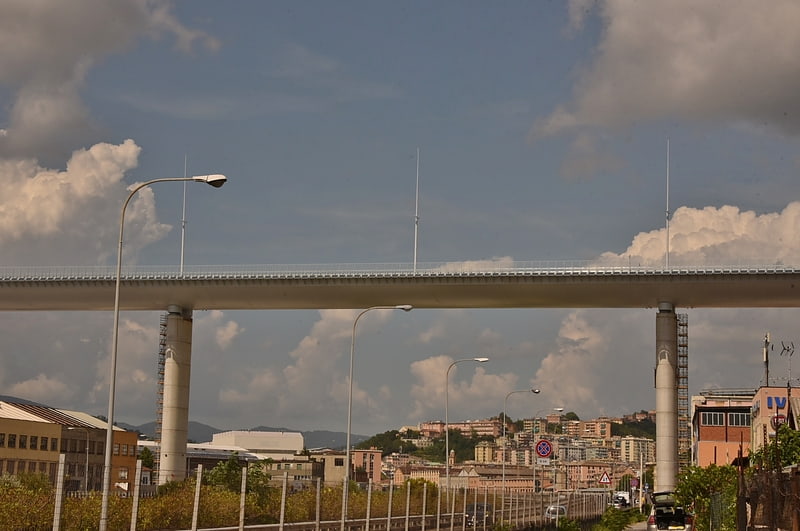
The Genoa Saint George Bridge is a motorway viaduct that crosses the Polcevera river and the districts of Sampierdarena and Cornigliano, in the city of Genoa. It was designed by architect Renzo Piano.
The bridge replaces the Ponte Morandi (Polcevera Viaduct), which partially collapsed on 14 August 2018 and was demolished in June 2019.
The new viaduct, with its associated junctions, constitutes the initial section of the Italian A10 motorway, managed by the concessionaire Autostrade per l'Italia, which in turn is included in the European route E80.
The new bridge was inaugurated on 3 August 2020.[26]
Locanda Spinola
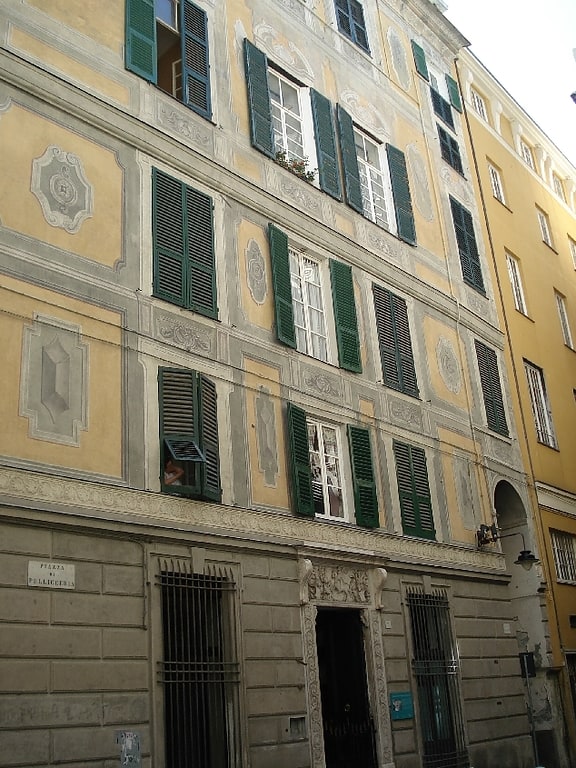
Also known as: Palazzo Pietro Spinola di San Luca
Palace. Palazzo Pietro Spinola di San Luca is a 16th-century palace in Piazza di Pellicceria, Genoa, Italy. It is now a private residence, and it remains in good condition. It is one of the Palazzi dei Rolli, but it is not listed by UNESCO as World Heritage Site.
The building faces the Palazzo Spinola di Pellicceria, overlooking the square. The building was included in the rolli of 1588, 1599 and 1614. It still has a well-preserved 16th-century atrium and a grand staircase, part of which was reconstructed after being damaged by bombardment in World War II.
The palace's façade contains an ornate marble portal decorated by reliefs of vines and bunches of grapes, and topped by a sculpture of Saint George and the Dragon.[27]
Address: Genoa, 3, Piazza di Pellicceria
Santa Maria Assunta
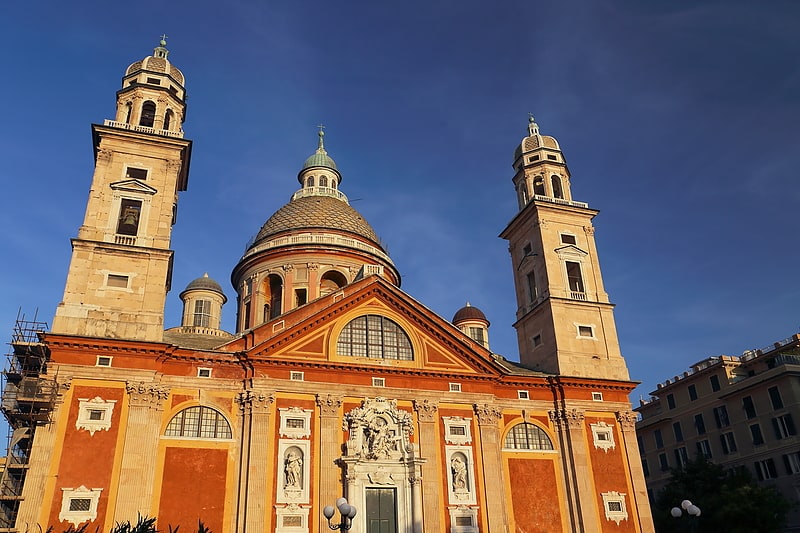
Catholic church in Genoa, Italy. Santa Maria Assunta is a Renaissance church in Genoa, Italy. It is located in a residential sector called Carignano located on the hills just above the city center, thus the church is also known as Santa Maria Assunta di Carignano.[28]
Address: Piazza di Carignano, 16128 Genova (Centro Est)
Villa Saluzzo Serra
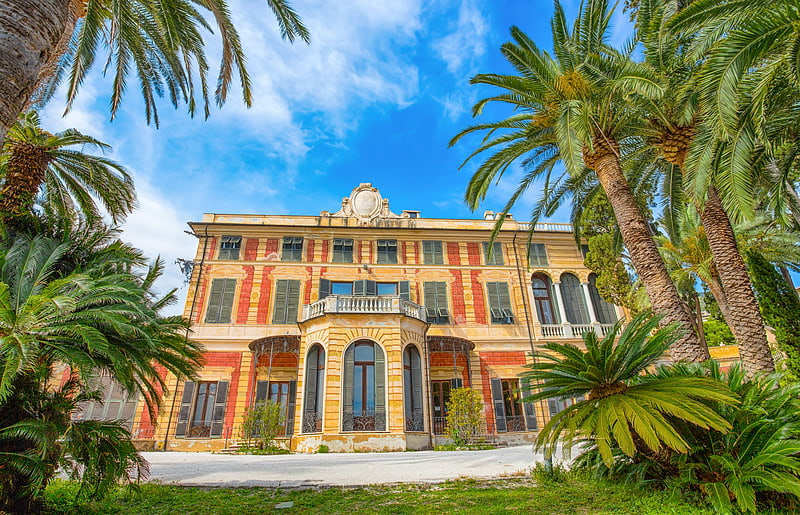
The Villa Saluzzo Serra is a civil building in the Nervi district, in via Capolungo, in the municipality of Genoa. Municipal property, and located in the parks of Nervi, it has been the seat of the Genoa's Gallery of Modern Art since 1928.[29]
Palazzo Bianco
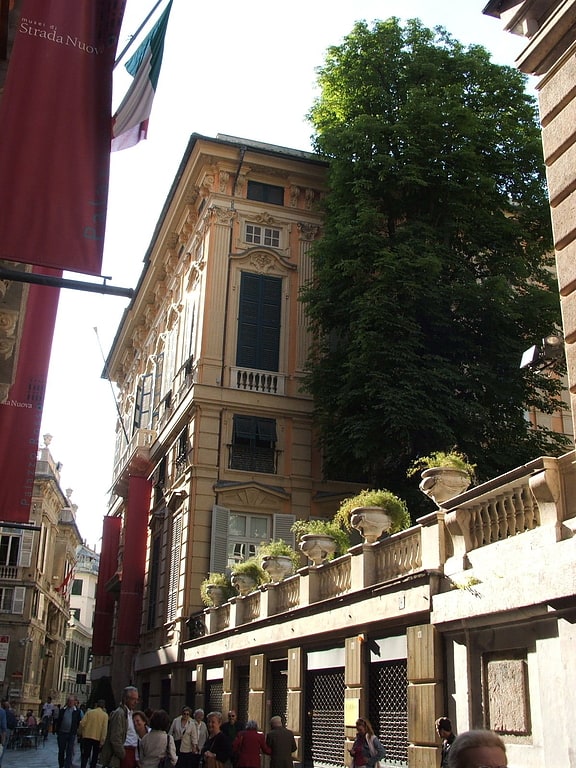
European artwork in Renaissance palazzo. Palazzo Bianco is one of the main buildings of the center of Genoa, Italy. It is situated at 11, via Garibaldi.
It contains the Gallery of the White Palace, one of the larger city art galleries, and together with those of its neighbors Palazzo Rosso and Palazzo Doria Tursi, it forms part of the Strada Nuova Museums, a cluster of museums at that end of the street.[30]
Address: Via Garibaldi, 11, 16124 Genova (Centro Est)
Palazzo Spinola di Pellicceria
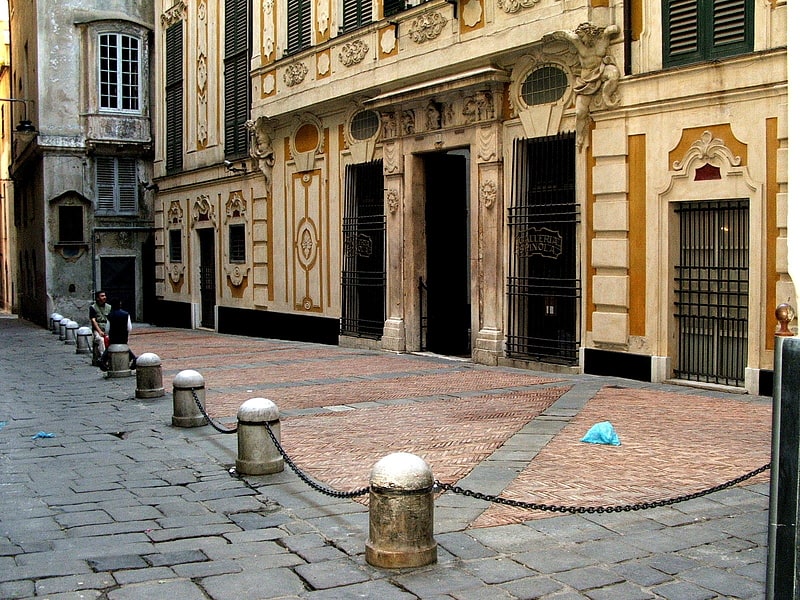
The Palazzo Spinola di Pellicceria, also known as Palazzo Francesco Grimaldi, is a palace located in piazza di Pellicceria in the historical center of Genoa, Northwestern Italy. The palace was one of the 163 Palazzi dei Rolli of Genoa, the selected private residences where the notable guests of the Republic of Genoa were hosted during State visits. On 13 luglio del 2006 it was added to the list of 42 palaces which now form the UNESCO World Heritage Site Genoa: Le Strade Nuove and the system of the Palazzi dei Rolli. It is currently owned by the Ministry of Cultural Heritage and Activities and Tourism and houses the National Gallery of Art in Palazzo Spinola.[31]
Address: Genoa, 1, Piazza di Pellicceria
Santa Maria delle Vigne
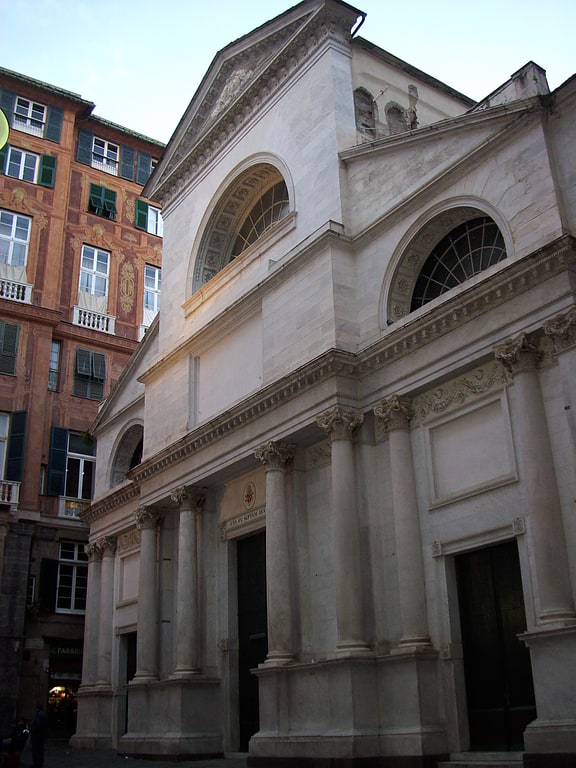
Church with ornate baroque decoration. Santa Maria delle Vigne is a Roman Catholic basilica church in Genoa, Italy. It was built in the 10th century. The main altar was completed in 1730 by Giacomo Antonio Ponsonelli. The church is also the final resting place of the leading early Italian composer Alessandro Stradella, who was murdered in 1682.[32]
Address: Vico del Campanile delle Vigne, 5, 16123 Genova (Centro Est)
Basilica della Santissima Annunziata del Vastato

Big cathedral with frescoes and other art. The Basilica della Santissima Annunziata del Vastato is the Catholic cathedral of Genoa, northern Italy; its decoration employed the major baroque studios and artists in Genoa in the 17th century.
It is named Vastato because the area where it was built was outside the walls of the city, in an area where houses had been demolished (devastated) for defensive reasons. In Latin, vastinium referred to a safety belt within the protective bastions.[33]
Address: Piazza della Nunziata, 4, 16124 Genova (Centro Ovest)
Chiesa di Santo Stefano
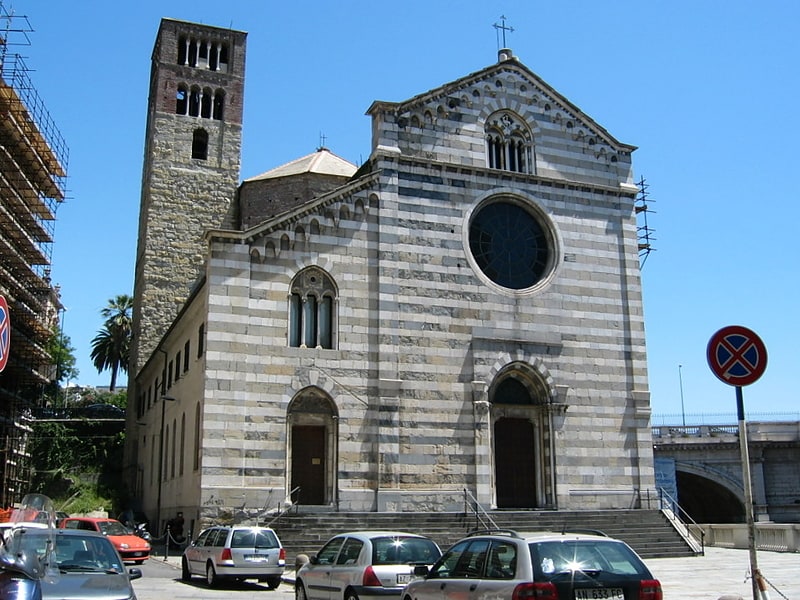
Catholic church in Genoa, Italy. Santo Stefano is a church in Genoa, northern Italy. Located on a hill overlooking the central Via XX Settembre, it is one of the most outstanding examples of Romanesque architecture in the city.
The church had been closed for much of the 20th century, until the restoration of the year 1946-1955, when it was reconsecrated.[34]
Address: Piazza Santo Stefano, 2, 16121 Genova (Centro Est)